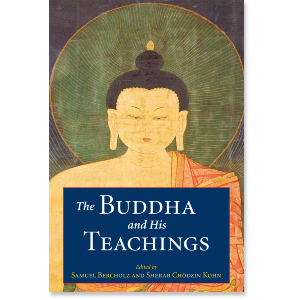by Wendy Garling, author of Stars at Dawn
Why Trees?
Those familiar with the Buddha’s biography know that all major events in his life took place under trees. He was born under a shala tree (shorea robusta), for example, as his mother Maya stood upright and grasped a branch with her right hand. Young prince Siddhartha experienced his first deep meditation under a rose-apple tree. Years later, the Buddha’s enlightenment took place under a spreading fig tree (thereafter called the bodhi tree), while at the end of his life he attained parinirvana lying between two mighty trees, again shalas.
So why trees? No particular significance is noted in the stories, yet looking deeply into original biographies as recorded in Sanskrit and Pali literature, the trees in these episodes (and others) play a critical role in the unfolding storyline. No ordinary trees as we might perceive them, they embody a fully aware feminine presence—one that is interconnected with the events at hand and deeply invested in Siddhartha’s destiny to become the Buddha. Prescient and nurturing, these trees-cum-goddesses are expressions of the sacred feminine in the natural world, asserting themselves at key moments over the course of the Buddha’s life as protectors, facilitators, witnesses, or celebrants. Looking back, these tree-goddesses provide windows into the cultural imagination of early Buddhism, where narratives esteemed the feminine principle and understood it as playing an essential role in bringing the Buddha, hence dharma, to the world.
A More Complete Retelling
Let’s look again at the above episodes in the Buddha’s life and retell them with a more complete look at early literary fragments. Of course, the retelling requires some reimagining . . .
In the full bloom of pregnancy, the Buddha’s mother Maya travels with her assembly of women to Lumbini’s Grove (named for her grandmother), to give birth to her child, a son prophesied to become either a great king or a great saint. Within a vast and deep forest, Lumbini’s Grove is the chosen destination because it is a sacred birthing place protected by the compassionate and nurturing goddess, Abhayadevi. For generations the women of Maya’s clan have given birth there, where no men are permitted and where the women gather to assist and share in ancient birthing practices. Maya arrives at the grove’s sacred shala tree—the embodiment of Abhayadevi—as pangs of labor overcome her. Knowing that the time of birth has come, the goddess gently lowers her branches to offer Maya support. With her sister Mahaprajapati holding her around the waist, Maya grasps a branch with her raised right hand, and effortlessly gives birth to her son, Siddhartha, thirty-five years later to awaken as the Buddha.
Siddhartha and the Sacred Tree
In another episode involving a sacred tree, Siddhartha is a toddler in the Pali sources and young man in most Sanskrit sources. Here it is springtime, and the prince leaves the palace with his father and family to observe the ritual first plowing of the fields. The versions vary quite a bit, but the crux of all the stories is that Siddhartha is left alone under the shade of a rose-apple tree where he goes into deep meditation. Hours go by and when his family returns, they are all startled to see that the tree’s shade over him never shifted as the sun crossed the sky. This event, deemed a miracle by the witnesses, is one that is never explained well in conventional accounts. Early story fragments, however, tell us the rose-apple tree embodied a goddess who orchestrated the whole thing. Her impulse to protect the young prince from the hot sun, while a motherly gesture on the one hand, also facilitated his first meditation. With the wisdom of the sacred feminine, she had her eye on the bigger picture—his impending buddhahood. Providing shade was her simple act of supporting him along the way. In this story she speaks,
As Siddhartha meditates under the rose-apple tree, the power of his fierce concentration is such that it generates an energetic field in the sky. This disrupts the flight of five rishis who are airborne making their way to the Himalayas [yes, flying is often the preferred method of travel in these stories]. The grumpy rishis complain and are overheard by the goddess of the rose-apple tree who, knowing Siddhartha’s destiny, explains to them what is going on, “It is the Sakya Prince descendant of the best of kings, who shines like the dawn . . . .His power, gained from merit in millions of lives, is thwarting your [flight].” Thus chided, the rishis together with the tree goddess bow down to the prince. [Lalitavistara, chap. 11].
The Bodhi Tree
Even the bodhi tree, site of the Buddha’s awakening, had a designated goddess according to some accounts. She is named in addition to the goddess Prithivi, who emerged as the Bodhisattva touched his right hand to the earth during the enlightenment sequence. The bodhi tree goddess tended the bodhi tree for countless eons, her job to keep it watered and nurtured while waiting for a new buddha to appear. With news of Gautama’s impending arrival she joyfully springs to action in woman goddess form, sweeping the bodhimanda (seat of awakening) with her broom and sprinkling it with fresh water and flower petals. In the following story, she appears to the evil demon Mara in a display of fierce compassion.
Mara is exhausted from his efforts to subvert Gautama’s enlightenment and seize the bodhimanda for himself. Abandoned by his armies, disoriented with confusion, the demon collapses in a heap by the bodhi tree, terrified and alone. This spectacle prompts the tree’s goddess to appear. Reviving Mara by dousing him with water, she goads him to his feet with fierce, wise words, “Quick, get up! You must depart without delay! For this is what happens to those who pay no heed to the words of the Master. A fool who offends against those who are faultless shall himself meet with many troubles.” [Lalitavistara, chap. 21]
The Sacredness of Trees
The sacredness of trees is expressed again at the time of the Buddha’s death (or parinirvana). In his final hours, the Buddha lay reclining in a forest grove sheltered by two magnificent shala trees. Out of season, they spontaneously burst into fragrant blossoms, showering him softly with petals in a display of reverence (perhaps also tears). All surrounding trees—in fact, those throughout the universe—bowed toward him with similar expressions of fecund exuberance as Mother Nature’s beauty in all its forms exceeded anything that had ever been seen,
Not only these two trees, but all those of that forest, and also those in ten thousand worlds, exhibited the same wonderful and graceful appearance. All the fruit trees yielded out of season the best fruits they had ever produced; their beauty and flavor exceeded all that had ever been seen. The five kinds of lilies shot forth from the bosom of the earth, and from every plant and tree; they displayed to the astonished eyes the most ravishing sight. The mighty [Himalaya mountains] shone with all the richness of the colors of the peacock’s tail. [Bigandet, 2:46]
These and more stories of the sacred feminine flowed from oral traditions that emerged during the Buddha’s era in India but mostly vanished as written records took their place. We are fortunate to have a few remaining glimpses into an earlier Buddhist world where the feminine principle was not only revered but perceived as integral to the birth and unfolding of the new faith.
Sources
Dharmachakra Translation Committee. Lalitavistara (“The Play in Full”). Translated from the Tibetan. New York: 84000, 2013. http://read.84000.co/browser/released/UT22084/046/UT22084-046-001.pdf.
Bigandet, Paul, trans. The Life or Legend of Gaudama, the Buddha of the Burmese. London: Kegan, Paul, Trench, Trübner & Co. Ltd. 1911-12.
Related Books
$24.95 - Paperback
$39.95 - Paperback
$12.95 - Paperback
$21.95 - Paperback
$15.99 - eBook








